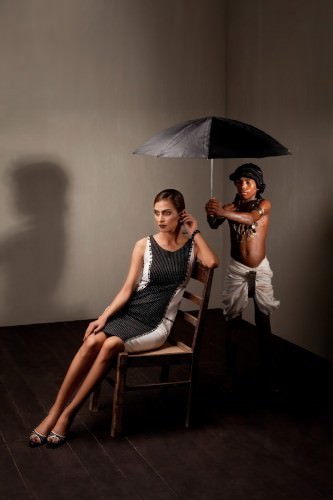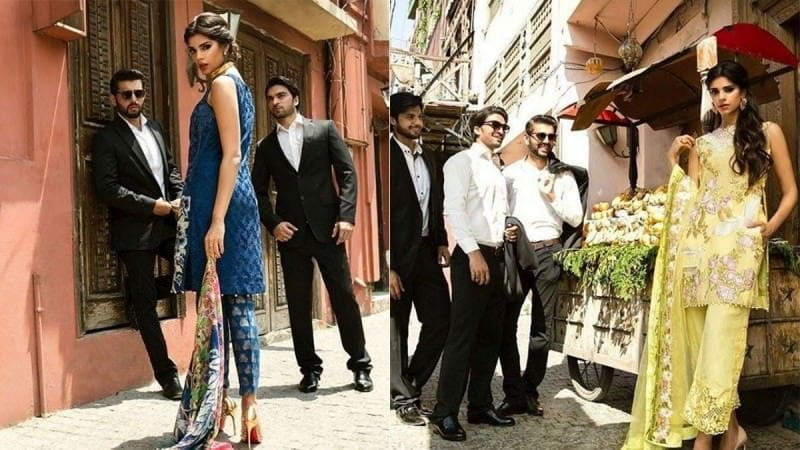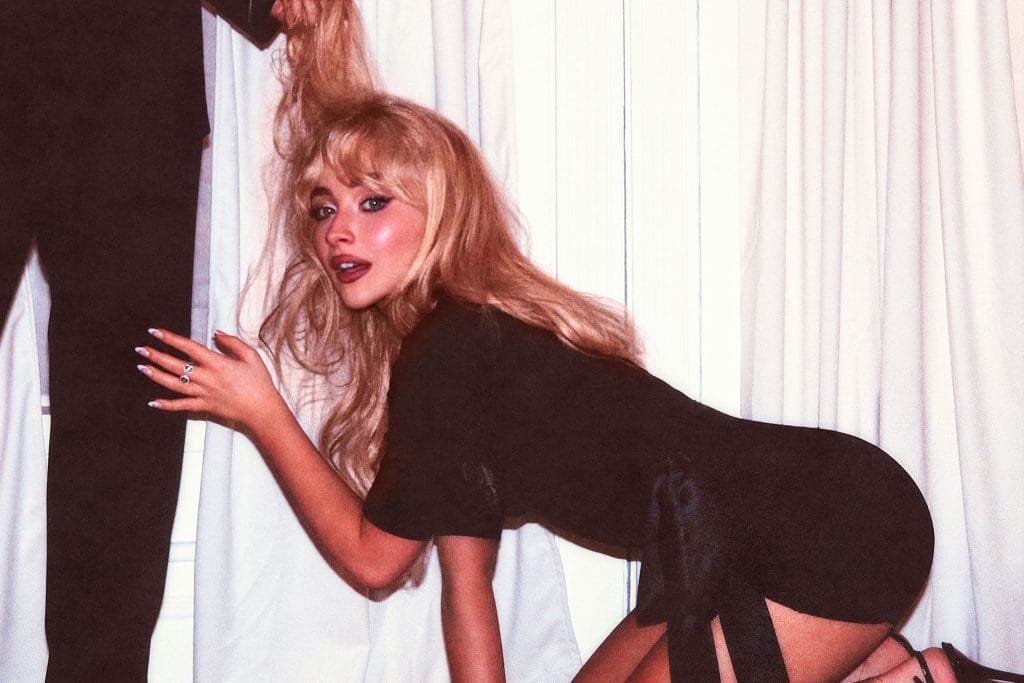Famous Pakistani designers, Ali Xeeshan and Saira Shakira faced heavy criticism on social media platforms for their new designer collection campaigns. Critics say that the photo shoot for the campaign glamourises rape culture and street sexual harassment. Saira Shakira did a photo shoot campaign called ‘Life of a Diva‘ with actress and model Sanam Saeed for her brand called Crimson. The photographs portray a young woman being gazed at on the streets. On the other hand, Ali Xeeshan has come under fire for a similar natured photograph for his designer brand, featuring Hasnain Lehri and Amna Babar. This photograph is as disturbing as those from Saira Shakira’s campaign. We see a man (Hasnain Lehri) clutching the fist of an obviously frightened woman (Amna Babar), who is trying to break free of his grip.
These photo shoots are being shunned by masses of people on Twitter and Facebook, as it romanticizes harassment against women. People are calling out the designers to demand an explanation for this carelessly thought photo shoot idea. Social media platforms like Twitter and Facebook were flooded with opinions and backlash. Girls at Dhaba said,
“This is extremely problematic and frankly quite sickening. Designers like Saira Shakira romanticising rape culture for profit. smh. Photos seemed to have been taken down and/or strategically cropped now, but we want a public acknowledgement and apology by Saira Shakira. We have received messages from people who are very disturbed by this and we want to ensure accountability so that this is a clear message for all outlets.”
Saira Shakira later issued an explanation to justify the motive behind the photo shoot and to issue an apology regarding the whole situation. She and her team believe that the images have been misinterpreted by the people and sensationalised through social media.

Ali Xeeshan too faced a lot of criticism for glamorising the rape culture and the helplessness of a woman against an intimidating man. Twitter went into a frenzy and criticised the designer along with the models, photographer and creative manager. A commenter on Twitter wrote, “Is fashion promoting and glamorising rape culture?” while another quoted, “This is disgusting to the point of being tragic. Rape is not erotic by any which way.” Many Twitter commentators called Ali Xeeshan out to offer an explanation for the concept behind the theme of the shoot. One such commentator said, “Hey ALI Xeeshan not sure what’s going on here. Is the guy forcing himself on the girl? Is that supposed to be erotic?”
Sonya Rehman, a cultural journalist, says, “Let’s get one thing straight: this isn’t a witch-hunt, however, I do believe that those in the spotlight need to be careful about what they’re putting out there given their fan-following.”
Adding further, she said, “The image from Ali Xeeshan’s shoot featuring a dishevelled model, Amna Babar, trying to break free from model Hasnain Lehri’s grip left a bitter taste in my mouth. In a country where physical, sexual and emotional abuse against women is widespread and common, I found nothing appealing about the image. To put it mildly, it was revolting. The intensity of the image; the male model’s blatantly aggressive disposition as he clutches his female model’s hand (as she struggles to break free) is NOT sexy. That is NOT fashion. In what universe is that even remotely attractive?”
Sonya expressed her remorse on the entire situation of victimising women in pop culture by elaborating, “Who said apparel and accessories needed to depict alpha male machismo and a submissive, pleading woman? You’re basically packaging abuse – trying to make it look hot – and feeding it back to an audience (already crippled by an accepted, patriarchal notion of violence against women) and saying; Here, woman, buy your subservience! Irresponsible.”

However, the acclaimed designer has since removed the photograph from his Instagram handle and has said, “This shoot was my way of showing a mirror to the society and depict [sic] that many men behave like this with women. I did not mean to glamorise female abuse. However, I have now removed the image from my Instagram. Perhaps in our society, we prefer to turn away and are not yet ready to admit what’s wrong. All we want to see is beautiful imagery.”
Abira Ashfaq, a feminist and a human rights activist, explains what exactly is wrong with these photo shoots and others of a similar nature, “Any ad campaign that projects harassment/rape and violence against women in a glamorous//sexy was is normalising VAW and sending a message that it is ok to harass women. These crimes are not sexy or glamorous. They are playing into and creating myths and stereotypes that women don’t mind these catcalls, they accept them, a no means a yes, women like a bit of roughness, or that men somehow cannot be restrained and it is an expression of their desire. These are all false! These images have nothing to do with romance, desire or even fashion for that matter – these are indicative of an unethical industry and a male oriented, patriarchal culture where VAW in internalised and find deep-seated acceptance.”
She added, “It is part and parcel of a culture that privileges men in public spaces – they can use and own public spaces while women often find themselves feeling stifled, controlled, and stared at in public. Such a campaign normalises street harassment and makes it acceptable and even cute, whereas women’s lived experience is that it is repugnant, traumatic and a crime (See Section 509 of the Pakistan Penal Code) and we should be actively calling it out. We should strive to make streets safe for women and girls rather than offering impunity and a blank check to harassers.”
This is not the first case Pakistani designers have stirred up a controversy through their campaigns and photo shoots. Acclaimed Pakistani fashion designer, Aamna Aqeel came under fire for her fashion campaign “Be my Slave” in 2013. The photo shoot was called out for being racist and insensitive towards the minorities and dark-skinned individuals. However, labelling women and victimising them to sell products is nothing new in the pop culture industry of Pakistan. From television commercials to drama serials and now fashion campaigns, women are victimised and portrayed to be fragile, helpless and coy. This stereotypical image of a woman has been integrated in the minds of masses for decades and implies a certain manner in which a woman is supposed to mould herself.


So the question remains, is media and pop culture industry portraying women as victims and stereotyping them for the sake of selling brands and garnering TRPs? Can empowered women not sell products like victimised ones? Afia Salam writes for Aurora and reflects on the matter, “Crimes against women take on a totally different connotation. Life shattering crimes like rape, or acid attacks are trivialised, the victim’s privacy violated, dignity crushed and innocence questioned. The suggestive, offensive headlines, lurid pictures and accompanying text go a step further when the crime is committed by a woman; Ayyan Ali’s involvement in the money laundering is a case in point.”


Opinionated and empowered women have always been stereotyped as home wreckers, unfaithful and disloyal to their loved ones. These concepts are perpetuated in the minds of the masses through media and pop culture. TRP shattering drama serials like Humsafar, Maat etc. portray headstrong and independent women in an antagonistic light and timid, homely and weak women as protagonists and role models. Unfortunately, serials like Dil Lagi, Sangat etc. go as far as celebrating rapists and stalkers as heroes and plot driving protagonists. Television commercials, similarly, celebrate women as mothers, homemakers, wives and daughter in laws. The idea of a perfect role model of a woman is created in the domains of this mould. These ideals are then presented to masses who adopt them in their real lives.
When asked about the possible strategy behind the campaign, Abira Ashfaq added, “They (campaign strategists) are either clever and conniving enough to know this is misogynist and want their product to gain attention through controversy and feminist critique; or they are stupid and sexist and just don’t realize how problematic these images are – and are just pulling them out of the sexist archives of their mind and thinking they are brilliant.”
However, there has been a positive turn in the events recently in the pop culture and media industry of Pakistan. A lot of positive content is also being created to raise awareness regarding various issues of the society and to break the stereotypical mould that is set for the women. A delightful example of this is drama serial Udaari, aired on Hum TV Network, which aims to educate people regarding the monstrosity caused by child sexual abuse. Udaari is the first drama serial of its kind to take up this bold topic and attempt to aware people regarding it. Apart from this, almost all the plot driving protagonists in this show are women who come from very different backgrounds and possess different personalities. This show has been appreciated and the creators are widely praised by the masses for taking up this bold and sensitive topic and imparting a positive and effective message through it.

Rape culture and street harassment are real problems faced by women in Pakistan on a daily basis. The solution to these problems is discussion about them on open platforms instead of trying to shroud the facts. In the words of Abira Ashfaq, “Constant dialogue with youth, at schools and colleges especially…make them call it out (is the solution to this dilemma). Engage in principled discussions on women’s rights, VAW, feminism, and law.” A responsible behaviour and campaigning like Udaari is required to bring about the desired change. A change can only be brought about if the problem is realised.
About the author(s)
A Pakistani journalist and Culture & Gender scholar at the University of Sydney, Amna Nasir considers herself a hard-core feminist. She is a travel enthusiast and expresses herself through painting, sketching, photography and writing. As clichéd as it may sound, Amna believes in equality of all beings irrespective of their background, colour, gender, religion or ethnicity.




